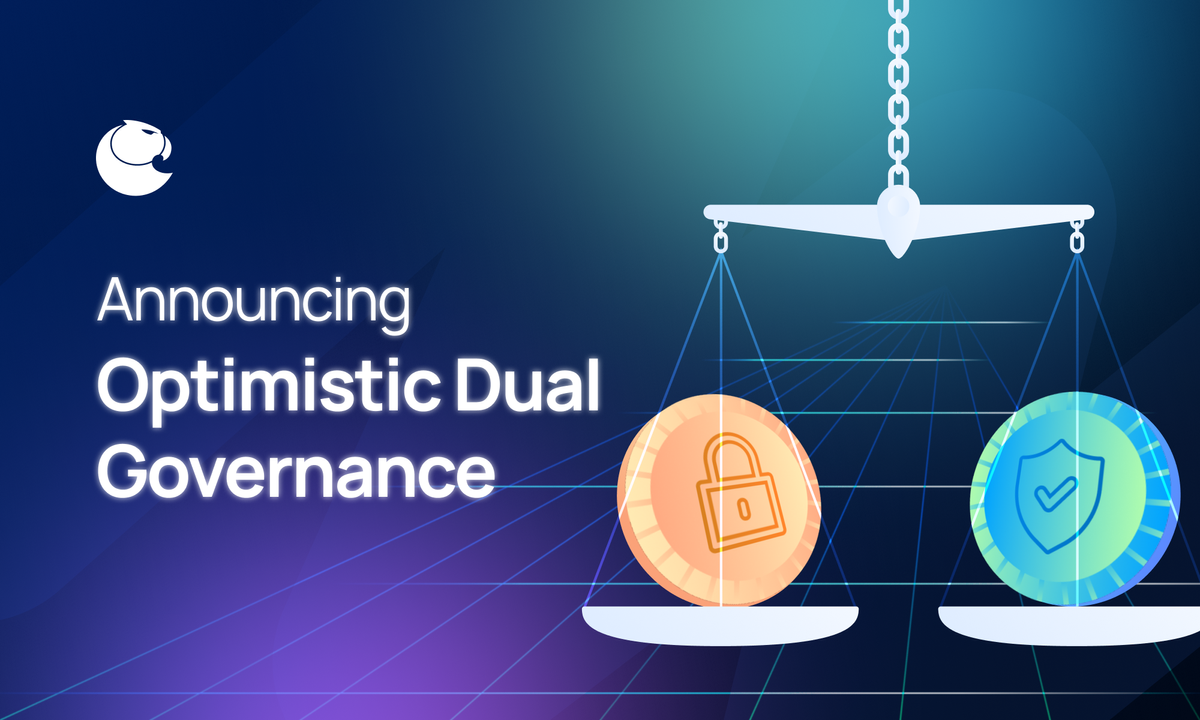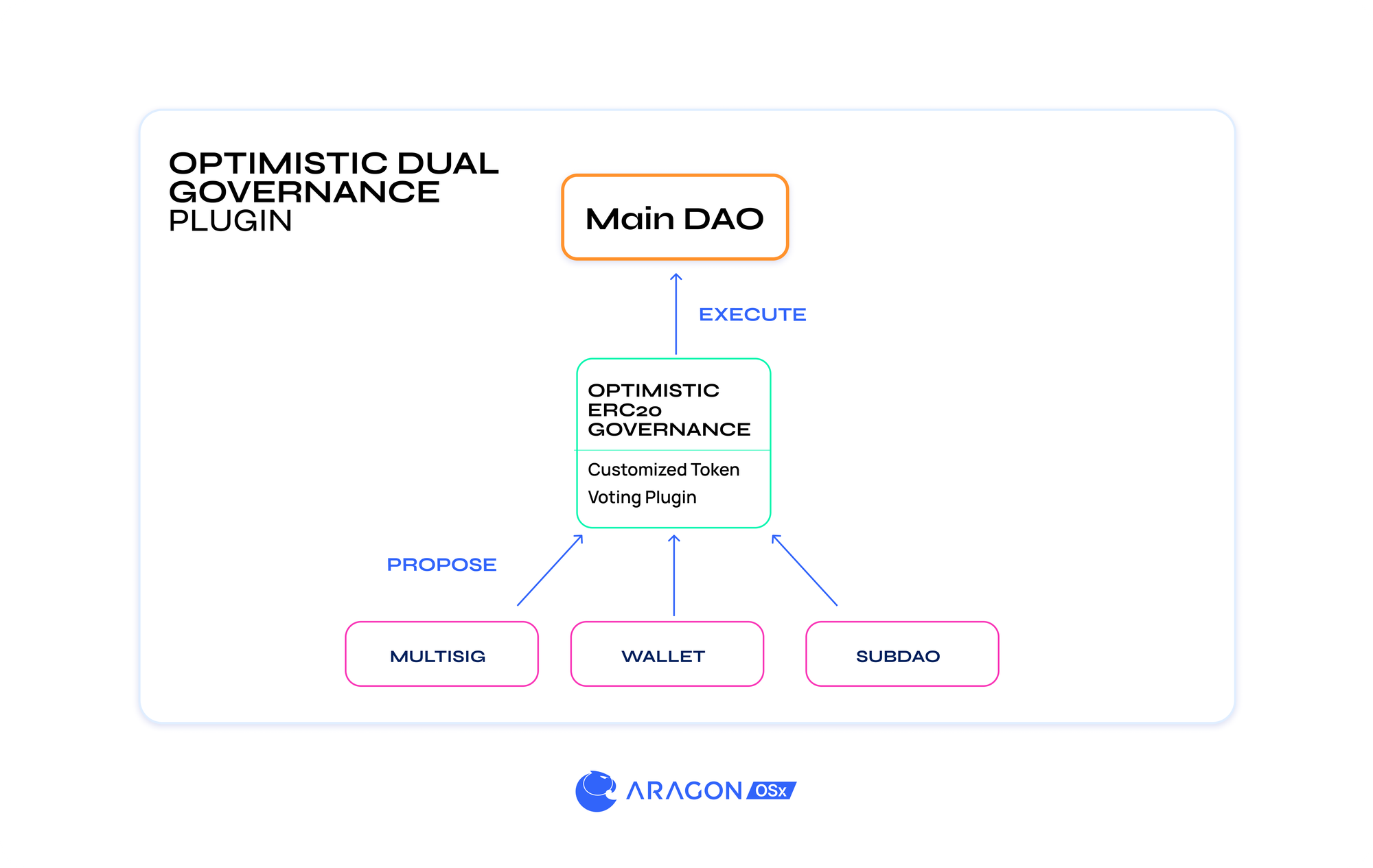Efficient governance design using Aragon OSx plug-in

Introducing Optimistic Dual Governance, a plug-in efficient governance design on Aragon OSx. This governance design allows the DAO to create two different stakeholder groups with different governance rights and then optimistically execute proposals.
The plugin will be audited, but you can check the progress of your first implementation. here.
Simply put, Optimistic Dual Governance allows your team to work efficiently while allowing key stakeholders to reject proposals.
Although you can define any type of stakeholder group to meet your organization’s needs, this dual governance design was created for Protocol DAO with two groups in mind:
- Teams actively building protocols or performing operational work: There are core teams, guilds, developers and other active participants who make updates, parameter changes and upgrades to the protocol itself.
- Members of the main DAO: An arbitrarily defined group of stakeholders that can be users, liquidity providers, stake holders, investors, governance token holders, or other groups interested in protecting the protocol but not actively involved in its operation, development, or changing its parameters.
After defining the stakeholder groups, the next component of this design to understand is optimistic governance.
Optimistic governance is where proposals pass unless vetoed. Instead of standard token-based governance, where proposals must be voted on to pass, proposals with an optimistic governance structure are automatically passed after a certain period of time.
This means teams can move faster and don’t have to submit proposals through traditional governance processes. However, if offer creation is open to the wallet, an attack surface is created. For example, if a major DAO passes a proposal that misuses treasury funds, there is no way to reverse its implementation. Therefore, it is safer for the DAO to have a defined group (in this case an address whitelist) that can be held accountable for proposals.
The design is heavily inspired by teams that have been exploring optimistic dual governance for their own DAOs, including: lido and SteakFLIP. that much design The writings of Jacob of Zora were also an important inspiration.
Here’s how Aragon OSx’s optimistic dual governance works from proposal to execution.
- Write a proposal: Multisignatures or child DAOs in the proposal whitelist can generate proposals to the primary DAO.
- Timelock period: During the timelock, key DAO members can reject the proposal.
- execution: If the main DAO does not reject the proposal during the timelock, the proposal will be automatically executed.
Check out the architecture in the diagram below.

that much permission management system The core of Aragon OSx enables a compact and efficient optimistic dual governance design. This allows the main DAO to have separate powers from child DAOs, but allows all DAOs to operate within the same governance system.
This is the first iteration of this plugin. There are thousands of versions you can create to fit your organization’s needs.
For example, in future versions of this plugin, different types of offers may have longer or shorter time locks. For minor updates, the timelock will be shorter, making it easier for the team to push out smaller updates quickly, while for major updates, the timelock will be longer to ensure that key DAO members have enough time to review them.
We can work with your team to build the iteration of governance design that best suits your protocol. If you are interested in using optimistic dual governance, Contact us here.
“OSx is the Unix of Ethereum. A future-proof DAO framework for building DAOs we can’t even imagine today. Dual governance will play an important role in communities that need to iterate quickly while keeping valuable assets and rights in the hands of token holders.”
— Jordi, core OSx developer
Separate stakeholder groups into active and passive roles
simple Token-based governance Put all stakeholders into a single homogeneous group with equal power. But in reality, stakeholders range from active, high-context participants building the protocol to users and infrastructure providers who want protection but are not actively participating.
This governance design allows for the separation of stakeholder groups based on their roles required to manage the protocol. You can think of this as a group of active proposers and a group of passive rejecters.
Many key stakeholders may not want to actively craft proposals, especially those involving technology upgrades. But they do We want to make sure that any proposals that pass are safe and do not misuse funds, introduce vulnerabilities, or compromise the future of the protocol. The solution to this is dividing stakeholder groups and granting them different powers through Optimistic Dual Governance.
Effective governance allows your team to bring products to market faster.
Optimistic proposal execution means that the team’s proposal will be implemented unless it is rejected. This design allows the team to iterate quickly, benefiting the overall health of the protocol.
And even if voter apathy is an issue for the organization, the team doesn’t hesitate. There is no need to wait to get the votes needed to pass a proposal. It will automatically pass after the timeout period. Teams also don’t have to spend time moving proposals through multiple stages of voting or approval. Key DAO stakeholders still have final approval on the proposal, but policies and processes have been significantly scaled back.
Stakeholders in major DAOs maintain control through time locks and veto options.
Stakeholders in a passive role (users, investors, liquidity providers, etc.) do not need to actively vote to ensure that the protocol or product is maintained. However, they still have control because they can reject proposals that are inconsistent with the DAO.
This design allows token holders to have ultimate control over what happens to the protocol without having to actively participate in creating the proposal. You can review the proposal if you wish, but you do not have to vote unless you need to exercise your right to veto.
Option to have completely tokenless governance
One possibility of this design is that both the team and the main DAO could be completely tokenless. For a basic DAO, all you need is a whitelist of addresses with veto power. The team needs a whitelist of addresses that have permission to create suggestions.
You can use this governance design whether you hold advance tokens or do not release them at all. There are no design components that require issuing tokens.
Additionally, these permissions and their implementation can be customized in a variety of ways, such as assigning votes or adjusting time locks.
You can find the first iteration of the Optimistic Dual Governance plugin here. hereYou will be thanked.
For more complex organizations, a variation of this design may be more appropriate. Because it includes autonomy for subDAOs. It might look something like this: Multisig is an autonomous subDAO that can manage certain permissions on its own, such as the ability to add and remove new internal members. They can also have their own governance processes, such as token voting.
Governance minimization is a core goal of this governance design, and future iterations will make greater use of this concept. By making the governance process simple and secure, both stakeholders and team members don’t have to spend too much time on governance.
We are looking for partners to explore the boundaries of this model and get feedback from more industry stakeholders. If you would like to inquire about using this governance design in your DAO or protocol, please fill out the form above and let us know what you need!
We can’t wait to hear what you’re building.



